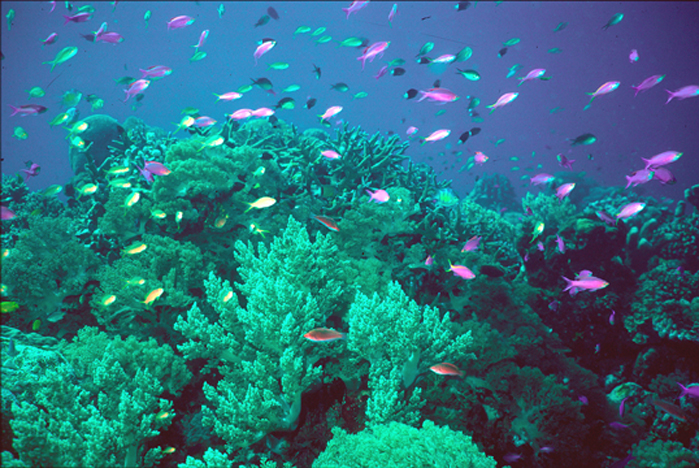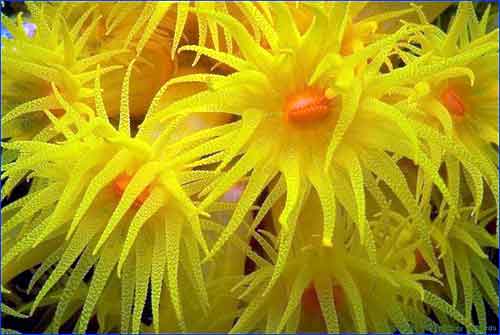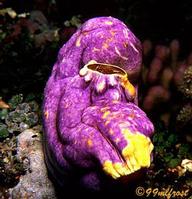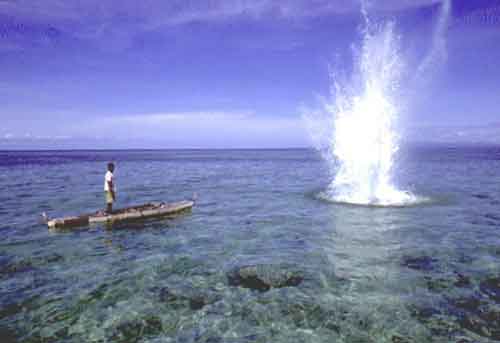
Coral reefs are the rainforests of the sea: diverse, vibrant, beautiful, and desperately endangered.
THE
DESTRUCTION OF CORAL REEFS

Anthropogenic fluxes are
causing the destruction of these systems.
1.
Defining and Understanding Coral and the Coral Reef
2. The Destruction of Coral Reefs
3. The Negative Effects of this Destruction
4. Sources

This organism is one species of coral polyp.
1. Defining and Understanding Coral and the Coral Reef
In order to
understand exactly why human actions have had
such a dramatic effect on coral reefs, it is necessary to understand
what coral
and coral reefs are and to know a little bit about how reefs form. This
knowledge will also help you to understand why coral reefs are so
valuable to
humans and why their destruction should be prevented.
Many people do
not understand the difference between “coral”
and a “coral reef”. Though these two terms are intrinsically related,
they are
not to be interchangeably.
Coral:
What we tend to refer to
as "Coral” is
actually the skeletal remains secreted by small marine polyps. Coral is
actually a tiny animal that looks like an upside-down jellyfish; It is
in the
same family as a jellyfish, classified as a benthic cnidarian. There
are
hundreds of species of corals, divided into two general categories,
soft corals
and hard corals. Soft Corals are treelike and flexible. Hard corals are
the
reef building corals we are most familiar with. Unless otherwise
specified,
“coral” will refer to “hard corals”.
Corals
form the Structure of a Coral Reef:
Baby coral polyps build
shells made by combining Carbon
Dioxide (CO2) and Calcium (Ca) to form Calcium Carbonate (also known as
Limestone). When polyps die, new ones land and form right on top of
them. The
physical structure of each coral reef is formed by millions of coral
polyp
shells. These colonies form the environment for all the organisms that
thrive
in coral reefs. Coral, essentially, is the building block which enables
all
other reef life to survive.

Purple Sea Squirts are one example of
rare and exotic life found in the reef habitat.
Life
in a Coral Reef:
The term coral reef refers
to a system composed not only of
corals and the physical structure their remains provide, but also of
thousands
and thousands of living organisms: fish, marine plants, sponges,
mollusks,
algae, etc

A magnified image of Zooxanthellae,
the algae necessary to coral survival
Zooxanthellae:
Zooxanthellae
is an algae essential to the survival of coral reefs. They live inside
coral
and share a symbiotic relationship with them. Zooxanthellae provide
oxygen and
other nutrients to the coral polyps and the polyps give the algae the
carbon
dioxide they need to survive. Zooxanthellae also give coral its
beautiful
color. Without Zooxanthellae, Coral have clear bodies and white
skeletons.
The
Formation of the Reef:
Coral Reefs require
specific conditions to thrive. They form
in shallow (depths of less than 27 meters) clear water where the
sunlight can
easily reach them. This is important because the zooxanthellae need
sunlight to
perform photosynthesis. They require a fairly narrow range of
temperatures
(between about 20 and 30 degrees Celsius) which is why they form in
warm
geographic regions. They require a salinity between 34 and 37 parts per
1000,
so they don’t do well near freshwater runoffs or in conditions where
the water
conditions change a lot. Almost all reefs grow in shallow waters
bordering
land, making them very vulnerable to anthropogenic fluxes.
The
Necessity of Coral to the Coral Reef:
Though coral reefs are not
composed solely of coral, the
survival of the organisms in the reef habitat is dependent above all on
the
survival of the coral formations. When the health of the coral is
threatened,
the existence of every other species is threatened, too. The
destruction of coral
is leading to the endangerment and extinction of thousands of other
species.
2.
The Destruction of Coral Reefs
Coral reefs are being
destroyed by anthropogenic fluxes in
their environment. These fluxes are caused both directly by people who
have
physical contact with the reefs and by all other people who contribute
to
earth’s pollution.
Direct Contact: Fishing
Humans destroy coral reefs
directly through unfriendly
fishing habits. Many coral reefs are overfished, destroying their
sustainability. In other areas, practices like cyanide fishing and
blast
fishing destroy reefs. Cyanide fishing is a method in which divers
squirt
cyanide into reef crevices and onto fish, stunning them and making them
easy to
catch. Small organisms, especially coral polyps, are killed by the
cyanide in
this process. Blast fishing, in which explosives or gun shots are sent
into the
reefs, can completely destroy the reef structure.

Unsafe Fishing Practices
result in the death of coral and other organisms that live in the reef.
Direct Contact: Tourist
Economies
Tourism has caused severe
damage to the
reefs. Corals are often removed from their habitat to be sold as
souvenirs.
Also, in some coastal areas with rapidly growing populations and
development, piers
and docks have been built right on top of coral reefs. Careless divers
often inadvertently
destroy coral reefs by kicking them or dropping anchors from their
boats
directly onto the coral. In poorer countries, septic waste from resorts
often
leaks out into the ocean, killing off the fragile corals.
However, much
of the destruction of coral
reefs is caused by people who have never even seen a reef. The
pollution which
has adversely affected the earth over the last century has had a
dramatic
effect on the health of the reefs.
Pollution: Global Warming
and Ozone
Depletion
Global
warming has translated into oceanic warming, the rising temperature of
earth’s
oceans. This process, combined with the depletion of earth’s ozone and
subsequent increases in ultraviolet radiation, has lead to what is
known as “coral
bleaching”. Coral bleaching occurs when the coral polyps, stressed by
changes
in temperature or UV radiation, expel the zooxanthellae which are
necessary for
their survival. This not only “bleaches” them and causes them to lose
their
color, it often leads to their death.
Pollution: Increased CO2
Increases in the amounts
of carbon dioxide found in water
have had an adverse effect on coral. The Carbon Dioxide seems to be
dissolving
the coral skeletons and making them much weaker. The process has been
compared
to osteoporosis in humans, and is leaving the fragile coral structures
weak and
even more vulnerable to anthropogenic fluxes.
Pollution: Water
Contamination
Oil spills, waste dumping,
and other byproducts of human
advances have resulted in the contamination of the oceans. When the
homoeostasis of the reef area is lost, there is an overgrowth of algae.
When too
much algae grows on the reef, the coral cannot get enough oxygen and is
the
reef is effectively smothered by Nitrogen and Carbon Dioxide.

3.
The Negative Effects of this Destruction
The End of Habitats with a
High Density of
Biodiversity:
Coral reefs are truly the
rainforests of the sea. They cover only about 1% of the ocean floor,
yet are
home to about 25% of all marine life- approximately 35,000 to 60,000
different
types of organisms. They are beautiful, lush, habitats brimming with
natural
resources.
The Demise of Economies
Dependent on Reefs:
Many humans are dependent
on Coral
Reefs for their livelihood. It is estimated that reef fish and mollusks
feed
between thirty and forty million people each year. Also, beautiful and
exotic reef
fish can also be sold as pets, providing cash income to families in
poverty
stricken areas. Tourism provides the basis for entire economies in many
regions.
With responsible treatment of the reefs, it would be possible to
sustain the
lives of people who have close relationships with the reefs.
The Loss of Natural
Coastal Protection:
Reefs form near the shores
of low
lying coastal lands. They are a natural barrier of protection against
currents,
strong waves, and storms. Without the reefs to slow the water before it
reaches
the shore, these areas are very vulnerable.
In one area where a reef was destroyed, it cost about $10
million per
kilometer to build a protective wall along the coastline.
Killing the Hope for a
Cure:
Coral reefs are probable
sources of
medicines to cure the diseases that currently plague the earth.
Chemicals found
in the reefs have been used to treat ulcers, heart disease, leukemia,
and more.
In one of the most famous instances, AZT, which is based on chemicals
extracted
from a Caribbean reef sponge, has been used to treat HIV infections.
Currently,
more than half of all cancer research is focused on finding cures from
marine sources.
Every time a reef is destroyed, the chance of relieving the pain and
suffering
of people all over the world is reduced.
In the background of this
beautiful scene, it is possible
to see the reef which protects the shore from destruction
.
Shrinking a CO2 Sink:
As mentioned earlier,
coral polyps
use Carbon Dioxide to form their shells. This helps decrease the amount
of
carbon dioxide in the ocean and is one way the Earth combats pollution
and
works to regain homeostasis. With less coral, the ocean absorbs less
Carbon
Dioxide, leaving more in the atmosphere.
4.
Sources
Oceanworld:
http://oceanworld.tamu.edu/students/coral/coral5.htm
Animal
Diversity Web:
http://animaldiversity.ummz.umich.edu/accounts/acropora/a._cervicornis$narrative.html
University
of Kansas
http://www.ur.ku.edu/News/99N/AprNews/Apr2/reef.html
Reef
Guardian International:
http://www.reefguardian.org/Campaigns/ReefBurial/MoreInfoSFlaReefBurial.html
UNEP:
http://www.unep.org/unep/gpa/padh/Tcoral.htm
International Coral Reef
Information Network:
http://www.coralreef.org